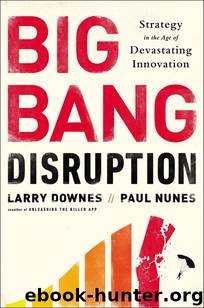Big Bang Disruption by Larry Downes

Author:Larry Downes [Downes, Larry]
Language: eng
Format: epub, azw3, mobi
Publisher: Penguin Group, USA
Published: 2014-01-07T00:00:00+00:00
CHAPTER 5
THE BIG BANG
SURVIVING CATASTROPHIC SUCCESS
Twitter only looks simple. The microblogging service appears to be little more than a multiuser text messaging service, distributing users’ 140-character “tweets” to groups of their followers, allowing them in turn to follow other users. Users can also retweet comments they like, and search globally for comments by topic. To outsiders, the service is just an enhancement to SMS messaging, which has been around for decades.
Yet Twitter’s unprecedented growth from a handful of internal users in 2006 to two hundred million in 2013 suggests something revolutionary has happened. Nearly half a billion tweets flow through the system every day. Celebrity entertainers, athletes, and politicians such as Lady Gaga, Cristiano Ronaldo, and Barack Obama have tens of millions of followers.
During popular events that range from Beyoncé’s pregnancy to the final moments of the European soccer championships to more serious subjects, including the earthquake and tsunami that devastated Japan’s coast in 2011, Twitter’s worldwide users tweet thousands of messages every second. Almost every television program urges its viewers to “follow us on Twitter and join the conversation.”
Twitter’s straightforward user interface brilliantly simplifies what is actually a highly complicated system. Behind the scenes, more than a thousand employees, mostly engineers, juggle a technical juggernaut that grows and changes faster all the time, testing the limits of network design and optimization. The service’s thousands of servers, routers, and switches have been architected to handle peak capacities of more than thirty thousand tweets per second during global events that can spike the site’s traffic, such as the Arab Spring that began in late 2010.
The company’s basic innovation of transforming short messages into a real-time, global social network has resonated with users in every category, geography, and interest. Estimates put the private company’s current value, as its owners prepare for a first public offering, at $10 billion.
Yet in the crucial early years of its existence, Twitter, like many Big Bang Disruptors, was nearly undone by sudden popularity. When users took to the service beyond the wildest dreams of its founders, the company lacked the infrastructure or the personnel needed to deliver a stable, commercial version of the product.
Indeed, at the time of Twitter’s public launch in 2007, it’s fair to say that the service was more experiment than commercial product. There was little of what one might call a business, let alone one prepared to become one of the most recognized brands in the world.
The most serious problems were technical. Twitter’s original design proved difficult to scale. Despite heroic efforts, well into 2008 the service regularly experienced ten or more hours of unavailability every month. During its frequent outages, Twitter’s highly addictive scrolling feed of tweets was replaced by the static image of a serene whale being lifted delicately out of the water by tiny birds. The “fail whale” became so familiar to frustrated users that they hardly needed the accompanying message, “Twitter is over capacity.”
Management “fails” exacerbated the engineering mishaps. The company had been founded by three young entrepreneurs, one
Download
Big Bang Disruption by Larry Downes.azw3
Big Bang Disruption by Larry Downes.mobi
This site does not store any files on its server. We only index and link to content provided by other sites. Please contact the content providers to delete copyright contents if any and email us, we'll remove relevant links or contents immediately.
Hit Refresh by Satya Nadella(9041)
The Compound Effect by Darren Hardy(8819)
Change Your Questions, Change Your Life by Marilee Adams(7640)
Nudge - Improving Decisions about Health, Wealth, and Happiness by Thaler Sunstein(7622)
The Black Swan by Nassim Nicholas Taleb(7016)
Deep Work by Cal Newport(6888)
Daring Greatly by Brene Brown(6451)
Rich Dad Poor Dad by Robert T. Kiyosaki(6414)
Principles: Life and Work by Ray Dalio(6226)
Playing to Win_ How Strategy Really Works by A.G. Lafley & Roger L. Martin(5937)
Man-made Catastrophes and Risk Information Concealment by Dmitry Chernov & Didier Sornette(5926)
Digital Minimalism by Cal Newport;(5669)
Big Magic: Creative Living Beyond Fear by Elizabeth Gilbert(5616)
The Myth of the Strong Leader by Archie Brown(5429)
The Slight Edge by Jeff Olson(5353)
Discipline Equals Freedom by Jocko Willink(5291)
The Motivation Myth by Jeff Haden(5158)
Stone's Rules by Roger Stone(5027)
The Laws of Human Nature by Robert Greene(5003)
